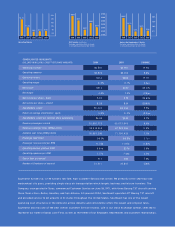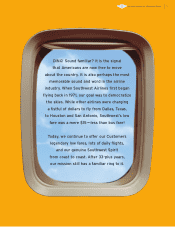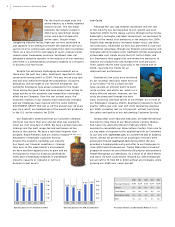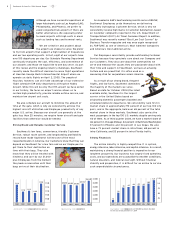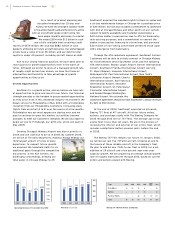Southwest Airlines 2004 Annual Report Download - page 9
Download and view the complete annual report
Please find page 9 of the 2004 Southwest Airlines annual report below. You can navigate through the pages in the report by either clicking on the pages listed below, or by using the keyword search tool below to find specific information within the annual report.
8Southwest Airlines Co. 2004 Annual Report
Although we have successful operations at
larger hub airports such as Los Angeles (LAX),
Philadelphia, and Phoenix, we prefer to
avoid congested hub airports if there are
better alternatives. We especially prefer
to avoid airports with high costs in areas
such as landing fees and terminal rents.
We are selective and prudent about
the airports we choose to serve. We prefer
to fly from airports that support a high number of frequencies
and our low operating costs. In fact, eight of our airports have
over 100 departures per day. Our Schedule Planning Department
continually evaluates the cost, efficiency, and convenience of
our airports and those we would like to one day serve. As part
of this review and the ongoing industry challenges, Southwest
recently made the difficult decision to cease flight operations
at Houston George Bush Intercontinental Airport where we
operate six daily flights on April 2, 2005. The people of
Houston, however, can still take advantage of our extensive
flight schedule (139 daily departures) at Houston Hobby
Airport. While this will be only the fifth airport we have exited
in our history, the focus on airport service allows us to
sustain high productivity, provide reliable ontime service, and
maintain low airport unit costs.
We also schedule our aircraft to minimize the amount of
time at the gate, which is why we consistently achieve the
highest aircraft utilization and Employee productivity of any
major U.S. airline. Because our aircraft are generally at the
gate less than 25 minutes, we require fewer aircraft and gate
facilities than otherwise would be needed.
Strong Brand and Reliable Customer Service
Southwest’s low fares, convenience, friendly Customer
Service, robust route system, and longstanding profitability
record have made Southwest Airlines one of the most
respected brands in America. Our Customers know that they can
depend on Southwest for a low fare and on our Employees to
get them to their destination on
time with their bags. They also
know that they will be treated with
kindness and care by our 31,000-
plus Employees from the moment
they book a reservation until their
bags arrive at their destination.
As revealed in A&E’s heartwarming real-life series AIRLINE,
Southwest Employees pride themselves on delivering
Positively Outrageous Customer Service, which is why we
consistently receive high marks in Customer Satisfaction, based
on Customer complaints reported in the U.S. Department of
Transportation’s (D.O.T.) Air Travel Consumer Report. In addition,
Southwest was recently named “Best Low Cost Carrier” by
Business Traveler magazine and was once again recognized
by FORTUNE as one of America’s Most Admired Companies
and America’s most admired airline.
Our Employees consistently provide outstanding Customer
Service because they genuinely care about our Company and
our Customers. They also care about the communities we
serve and embrace the causes they are passionate about with
their time and support. At Southwest, we have an amazing
Culture and are proud that it is often used as a
measuring stick for corporations across America.
As a result of our strong brand, frequent
flights, and low fares, Southwest dominates
the majority of the markets we serve.
Based on data for October 2004 (the latest
available data), Southwest is the largest
carrier in the United States based on
originating domestic passengers boarded and
scheduled domestic departures. We consistently rank first in
market share in approximately 90 percent of our top 100 city
pairs, and in the aggregate, hold over 65 percent of the total
market share in those markets. Southwest also carries the
most passengers in the top 100 U.S. markets despite serving only
40 of them. As of third quarter 2004, we have a market share of
46 percent in Chicago Midway; 44 percent in Baltimore/Washington;
37 percent in Phoenix; and 34 percent in Las Vegas. We also
have a 73 percent market share in intra-Texas; 68 percent in
intra-California; and 53 percent in intra-Florida traffic.
Strong Financials
The airline industry is highly competitive. It is cyclical,
energy-intensive, labor-intensive, and capital-intensive. As a result,
maintaining a strong financial position is imperative to our
longterm prosperity. Our business has largely fixed operating
costs, and our operations are susceptible to weather conditions,
natural disasters, and federal oversight. Without financial
stability and preparation, it is difficult for an airline to survive
such unpredictable circumstances.
1.25
1.0
.75
.50
.25
Customer Service
(Complaints per 100,000 Customers boarded)
For the year ending December 31, 2004
LUV
.18
ALK
.58
UAIR
1.21
NWAC UAL
.89
DAL
.79
CAL
.82
AMR
.88 .89
AWA
1.02
2000 2001 2002 2003
Operating Revenues
(in millions)
$5,650 $5,555 $5,522
2004
$5,937
$6,530 $7,000
$6,000
$5,000
$4,000
$3,000
$2,000
2000 2001 2002 2003
11:20
11:15
11:10
11:05
11:00
Aircraft Utilization
(hours and minutes per day)
11:18
11:10 11:12
2004
11:09
11:20

